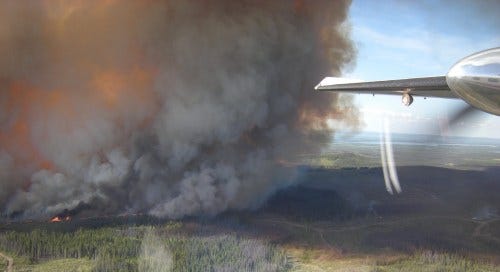Canada’s 2023 Wildfires Emitted More CO2 Than Most Countries, But Trudeau Escaped Bolsonaro-Like Treatment by Frances Martel
It has no federal emergency agency – the equivalent of the American Federal Emergency Management Agency (FEMA) – and no national fire authority.
Canada’s 2023 Wildfires Emitted More CO2 Than Most Countries, But Trudeau Escaped Bolsonaro-Like Treatment
in Agriculture, Extreme Weather, News
Reading Time: 3 mins read
A A
A study published this week found that Canada’s devastating 2023 wildfire season – which covered some of America’s largest cities with toxic plumes and affected 100 million Americans – resulted in Canada being responsible for more greenhouse gas emissions than any country on earth except China, India, and the United States. [emphasis, links added]
While responsible for a tremendous increase in greenhouse gas emissions in the past year, the administration of leftist Canadian Prime Minister Justin Trudeau largely escaped criticism, particularly from left-wing climate activists, for his poor handling of the fires.
Fellow leftist American President Joe Biden offered uncritical aid to the Canadian people in response to the fires, a stark contrast to his threat to destroy to Brazilian economy with sanctions in response to the 2019 Amazon wildfire season, when the country had a conservative president.
While excessively hot and dry weather played a role in the 2023 wildfire season, Canada’s government structure is poorly organized for handling large-scale fireworks .
It has no federal emergency agency – the equivalent of the American Federal Emergency Management Agency (FEMA) – and no national fire authority.
Trudeau has largely failed to organize efforts to properly manage forestsby removing highly flammable underbrush and other measures.
The prime minister squarely blamed “climate change” for the fires and urgedCanadians to “adapt to living with fire.”
The study, published in Nature magazine on Wednesday, found that the fires produced 647 megatons of carbon emissions, “comparable to the annual fossil fuel emissions of large nations, with only India, China, and the USA releasing more carbon per year.”
Notably, emissions from fires are not typically included in studies documenting greenhouse gas emissions produced by humans in any given country, so Canada has not formally appeared in the top spots of such lists despite the outsized amount of pollution it was responsible for in the past year. The fires have, instead, become a footnote in such reports.
“Although small compared to the emissions impact from fossil fuels and transportation, wildfires had an unusually large carbon footprint this year,” a year-end review by the University of Exeter and Stanford Doerr School of Sustainability noted in December, “with analysis of satellite records showing Canada’s emissions reached six to eight times the nation’s 20-year average due to an extreme wildfire season. Globally, fires contributed about 6 million tons of carbon dioxide during the first nine months of the year, 7-9% more than average.”
The Nature report noted that the 2023 fires occurred during an unusually, but not unprecedentedly, hot year.
Read rest at Breitbart





I am told that wood burning is carbon neutral, even when it includes energy use for harvesting,drying and shipping across the big pond. Surely, by the same logic, forest fires must be carbon negative.